- Share
The Great Moderation: Good Luck, Good Policy, or Less Oil Dependence?
Three explanations have been suggested for the moderation in real GDP and inflation that has occurred in industrialized countries since the 1980s: good luck, better monetary policy, and structural changes in the economy. Recent research finds that better monetary policy explains most of the moderation in inflation, and good luck and the less-intensive use of oil (a structural change) have played a major role in the moderation of GDP.
The views authors express in Economic Commentary are theirs and not necessarily those of the Federal Reserve Bank of Cleveland or the Board of Governors of the Federal Reserve System. The series editor is Tasia Hane. This paper and its data are subject to revision; please visit clevelandfed.org for updates.
Three explanations have been suggested for the moderation in real GDP and inflation that has occurred in industrialized countries since the 1980s: good luck, better monetary policy, and structural changes in the economy. Recent research finds that better monetary policy explains most of the moderation in inflation, and good luck and the less-intensive use of oil (a structural change) have played a major role in the moderation of GDP.
Sometime in the early 1980s, real GDP and inflation in industrialized countries began to fluctuate less widely than in the past. Economists have been debating the causes of this dramatic change, commonly referred to as the “Great Moderation,” ever since (see figures 1 and 2). Broadly speaking, three explanations have been suggested: good luck, better monetary policy, and structural changes in the economy. Economists of all stripes are interested in which is responsible, but monetary policymakers, in particular, need to understand the relative importance of each, as they may be in a position to keep up the good work.
Figure 1
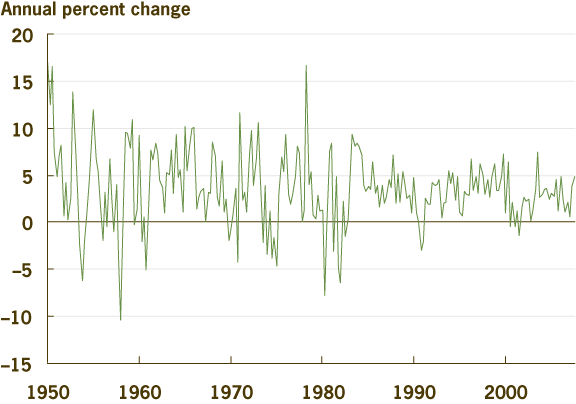
Figure 2
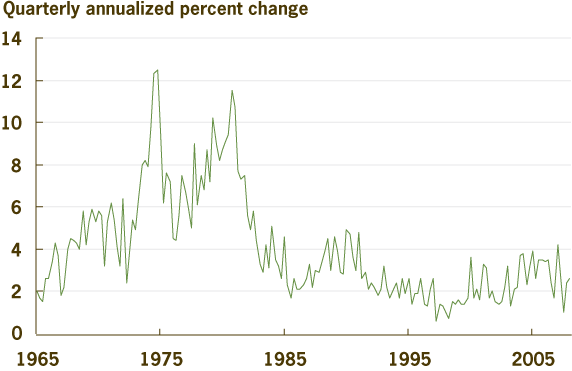
Good luck refers to the possibility that the remarkably benign series of economic shocks that have hit the economy in recent years has been the result of nothing other than chance. Some economists conjecture that stable oil prices have helped to produce these calm waters, because so much of industrialized countries’ output requires oil as an input to production, and most of these countries import their oil. While today’s rising oil prices may seem to spell the end of these good times, the percentage change in recent oil prices has been much less abrupt than in the 1970s (see figure 3).
Figure 3
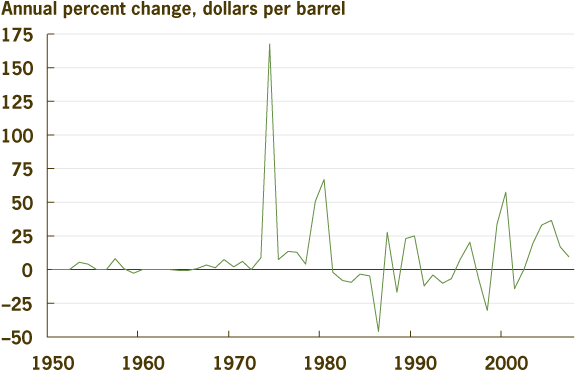
If good luck explains the moderation in GDP and inflation, though, there’s no reason to expect the moderation to last. But many economists argue that better macroeconomic policies are responsible, particularly monetary policy. If better monetary policy has helped to moderate swings in GDP and inflation, it is important to make sure that this good policy continues.
Inflation targeting is seen by some as the best way to do this. A credible target on low inflation helps central banks to stabilize not only inflation but also inflation expectations, which by themselves can be a source of macroeconomic instability, as they can affect interest rates and the real economy. Over the past few decades, most of the world’s major central banks have sought to keep inflation low, some going so far as to adopt explicit inflation targeting regimes, and proponents of inflation targeting see the great moderation as evidence of these policies’ effectiveness.
Other economists argue that the overall economy has undergone some sort of structural change and is now intrinsically more resilient to economic shocks. A look at the effect of oil prices on the economy provides an example of this resilience. Since 1983, increases in oil prices have had a much smaller effect on GDP—in the United States as well as most industrialized countries. Oil conservation efforts resulting from the oil price shocks of the 1970s are likely responsible for this reduced impact, for we now use oil more efficiently. The ratio of oil to GDP, which shows how much oil is needed to produce a given dollar of GDP, has fallen about 40 percent since the 1965–1983 period.
My recent research with Anton Nakov suggests that none of these explanations by itself accounts for all of the moderation in GDP and inflation variability, but each contributes something. We have quantified the impact of these causes on the moderation, and we find that while better monetary policy explains most of the moderation in inflation, good luck and the less-intensive use of oil (a structural change) have played a major role in the moderation of GDP.
The Oil Channel
In the past six years, oil prices have increased almost $80 a barrel (from an average of $20 in the first quarter of 2002
to $98 in the first quarter of 2008). Unlike the 1970s, this dramatic price rise has not been associated with an increase in inflation or a deceleration in economic activity. In the 1970s, the skyrocketing price of crude oil (it tripled in 1973 and then doubled between 1979 and 1980) was accompanied by two-digit inflation rates and deteriorating GDP growth in the United States and many other industrialized, oil-importing countries. It all culminated in three recessions within a span of ten years, the last of which (1981–1982) was the most severe recession in the United States since the 1930s.
The textbook explanation of the relationship between oil prices and economic activity assumes that when oil prices change, it will affect output and prices. A change in the price of oil is considered an aggregate supply shock, similar to a change in total factor productivity. When oil becomes more expensive (and thus is used less in production), both labor and capital are made less productive. Therefore, a price increase leads to less output, and, if the money supply is held constant, higher prices for consumer goods.
Empirical work of the 1980s that analyzed the relationship of GDP growth and oil price variations seemed to confirm the textbook interpretation. For example, in his seminal 1983 paper on the topic, James Hamilton observed that every postwar U.S. recession but one had been preceded by an increase in the price of crude oil, and he asserted a causal relationship from oil prices to GDP. Other authors found similar evidence of a link between oil prices and consumer prices in United States and also between oil and GDP, and oil and consumer prices, in other developed countries (see figures 4 and 5).
Figure 4
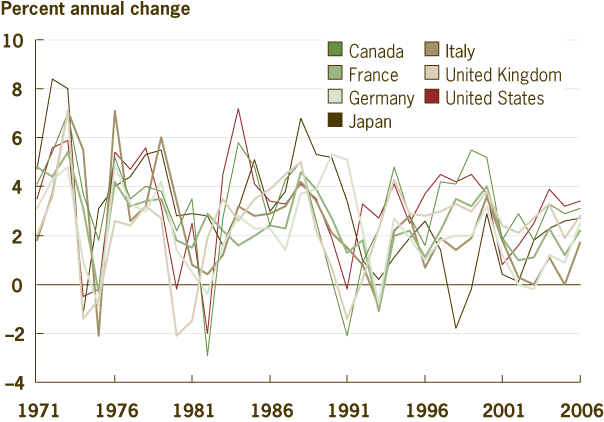
Figure 5
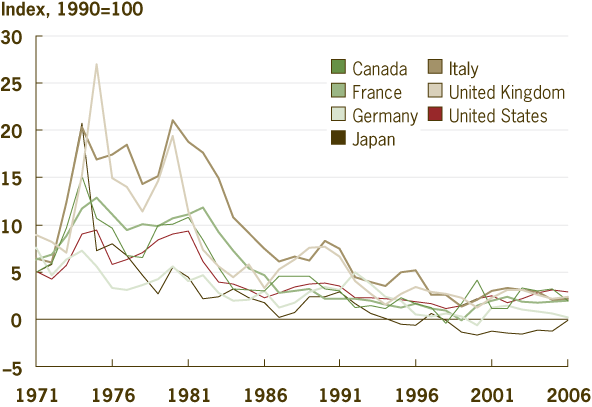
But studies after the 1980s produced mixed evidence: Mark Hooker found that after 1981, increases in oil prices had a smaller effect on GDP than before 1981. Similarly, Olivier Blanchard and Jordi Gali documented an important change in the transmission mechanism of oil shocks to economic activity and inflation in most industrialized countries. In particular, they found that the correlation between oil prices and U.S. GDP over the past 10 years has not been negative, as the textbook interpretation of an oil supply shock would imply, but positive (and moderately strong).
That oil affects the U.S. economy now less than during the 1970s is probably explained by the fact that, as I noted earlier, oil is used less intensively now. Because oil is less important as an input to production than it was three decades ago, increases in its price affect the productivity of labor and capital less than before. As a result, the relationship between oil prices and economic activity is likely to look less strong.
On the other hand, the explanation for why comovements of oil prices and U.S. GDP should have changed must lie somewhere else. Most existing theoretical work on the relationship between oil and the macroeconomy supposes that oil prices fluctuate for reasons that are independent of normal macroeconomic conditions. Rather, an oil well dries up, a pipeline is damaged by an ice storm, or a cartel decides it can get away with limiting supply to increase prices. By supposing the independence of oil prices from the macroeconomy, changes in oil prices can be interpreted only according to the textbook explanation, as a supply shock that impinges on people’s ability to produce and buy goods and services and leads to a negative correlation between oil prices and output.
But in actuality, oil prices are also affected by the demand for oil, which makes them dependent on (and pretty reactive to) conditions in the world economic environment. It is therefore not accurate to interpret every oil-price change as a shock from nowhere hitting the economy, for sometimes it may be the consequence of some underlying shock—such as a technological or financial innovation—which ultimately affects consumers’ demand for oil. When we assume that oil prices change in response to other economic factors, we can see that every shock that has a positive impact on world growth and, thus, energy demand, will generate a positive comovement of GDP and oil prices.
What this means for the issue we are considering is that we will need a model that can tell the difference between oil-price increases that are caused by shocks to the oil supply (like hurricane Katrina) and those caused by changes in the demand for oil. In order to quantify the relative importance of good luck, good policy, and structural economic change, our model must be able to disentangle these two possible causes of changing oil prices, so that the independent contributions of each to the moderation can be measured.
Quantifying the Moderation’s Possible Causes
In recent work, Anton Nakov and I investigated causes of recent U.S. macroeconomic stability. We estimated how much of it could be attributed to a reduction in the magnitude of shocks stemming directly from the oil sector and how much to the increased efficiency with which we use oil in production. To do this we took a microfounded model of the U.S. economy that is commonly used to analyze optimal monetary policy and augmented it with a foreign oil sector. This sector is characterized by a dominant producer (like OPEC in the real world) and a competitive fringe of smaller, capacity-constrained oil producers. These upgrades mean that our model incorporates the dependency of oil prices on other economic factors and takes into account the fact that the oil sector is not a perfectly competitive industry.
We combined this augmented model with macroeconomic data to produce a model of the U.S. economy before and after 1984. Then we performed counterfactual simulations to see how the economy would have behaved under different conditions, for example, had the oil-output ratio been different when an oil supply shock hit.
Results of all our simulations tell us that the moderation of U.S. GDP and inflation is substantially due to better monetary policy (especially for inflation) and smaller shocks hitting the economy (especially for GDP). While the latter result seems to support the good luck explanation, we could get the same result if permanent structural changes, such as the growing importance of the service sector, have altered the intrinsic volatility of GDP, inflation, or other aspects of the U.S. economy.
On the other hand, our approach does allow us to quantify the role of the oil sector: Our results tell us that shocks stemming from the oil industry (such as disruptions or the exhaustion of supply, innovations in extraction technology, or changes in the big oil producers’ market power) have only partially subsided, by about 15 percent, and this moderation of shocks has contributed to a 6 percent reduction in GDP volatility and a 10 percent reduction in inflation volatility. The primary effect of this moderation in oil-industry shocks is that real oil prices are now less volatile, by about 20 percent.
As I mentioned earlier, the U.S. economy has reduced its reliance on oil considerably. We find that this structural change has contributed significantly to the U.S. economy’s ability to insulate itself from oil-industry-related shocks. The reduction of the oil-GDP ratio, from 0.036 in 1965–1983 to 0.022 in 1984–2006, accounts for about 10 percent of the moderation in GDP growth volatility and 25 percent of inflation’s. In other words, if the U.S. economy of the 1970s operated at our current level of oil intensity, GDP would have been 10 percent less volatile and inflation would have been 25 percent less volatile. (For more detail, see “Oil and the Great Moderation,” in the Recommended Readings.) One curious effect of this same reduction in U.S. oil intensity is its effect on nominal oil prices: Everything equal, nominal oil prices fluctuate more widely now, by about 0.5 percent.
Significant increases in oil prices can be a difficult blow for modern economies to absorb and recover from. But it appears we are getting better at making our economies more resilient. Better monetary policy has kept inflation in check in the United States and other developed countries, and helped to moderate fluctuations in output. We have reduced our reliance on oil, and as a result, the U.S. economy is much better insulated today against shocks coming from the oil industry than in the past.
Recommended Readings
- “The Great Moderation,” by Ben Bernanke. 2004. Remarks at the Meeting of the Eastern Economic Association (February 20).
- “Has the Business Cycle Changed? Evidence and Explanations,” by James H. Stock and Mark W. Watson. 2003. Prepared for the Federal Reserve Bank of Kansas City Symposium, “Monetary Policy and Uncertainty,” Jackson Hole, Wyoming (August 28–30).
- “Inflation Scares and Forecast-Based Monetary Policy,” by Athanasios Orphanides and John C. Williams. 2003. Board of Governors of the Federal Reserve System, Finance and Economics Discussion Series, no. 2003–41 (August).
- “Oil and the Great Moderation,” by Antón Nakov and Andrea Pescatori. 2007. Federal Reserve Bank of Cleveland working paper, no. 07–17.
- “Output Fluctuations in the U.S.: What Has Changed since the Early 1980s?” by Margaret M. McConnell and Gabriel Perez-Quiros. 2000.American Economic Review, vol. 90, pp. 1464–76.
- “The Time Varying Volatility of Macroeconomic Fluctuations,” by Alejandro Justiniano and Giorgio E. Primiceri. Forthcoming in American Economic Review.
This work by Federal Reserve Bank of Cleveland is licensed under Creative Commons Attribution-NonCommercial 4.0 International




